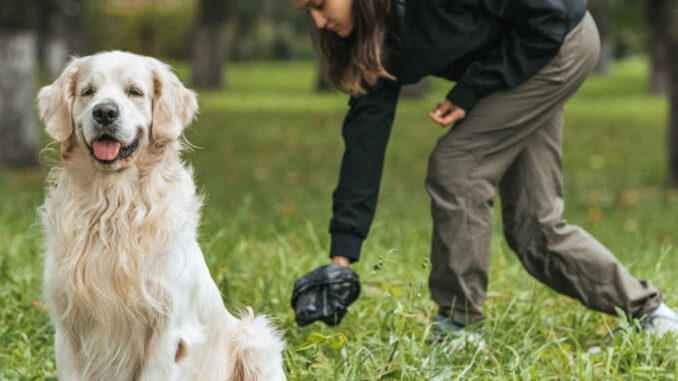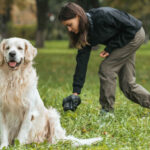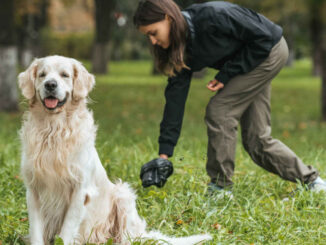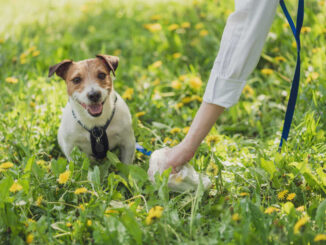
This article was updated on May 31st, 2023
Since we all have to pick up our dogs’ poop at one point or another, it’s likely fair to say that dog owners know pretty well when their dogs’ stools looks different from normal. Checking the stools is actually a good habit to get into, because the appearance of the stools is a very good indicator or a dog’s gut health. The same goes for mucus: in this article, we will discuss what mucus in a dog’s poop means, when it is a cause for concern, and, most importantly, what you should do about it.
What is mucus in dogs’ poop?
One common question that dog owners ask vets is: Why does my dog’s stools have a shiny, slimy, jelly-like material on it? Well, that material is actually mucus. Mucus exists in different parts of the body, and in the gastrointestinal tract (basically from the mouth down to the large intestine), mucus has an extremely important role for gut health.
Mucus is the material that forms on the outside layer of the gastrointestinal tract. It is produced in different quantities and different varieties, depending on where it is in the gastrointestinal tract. For example, the layer of mucus in the small intestine is thinner than the mucus in the stomach and large intestine.
The main functions of mucus are to protect the intestinal lining from digestive acids, to provide an environment that’s good for beneficial bacteria and bad for harmful bacteria, and to regulate the immune system. This mucus layer is shed in response to stresses to the GI tract, such as from a new dietary ingredient or an infectious organism.
Most of the time, large amounts of mucus in stools means that the large intestine is involved. Other symptoms that commonly occur along with mucus in stools include:
- straining to defecate,
- urgency to poop,
- increased frequency of defecation, and
- small volumes of stool.
- Sometimes there can be fresh red blood present as well.
How to evaluate what your dog’s mucus looks like
There are three main things to evaluate when looking at your dog’s stools: color, consistency, and presence of blood or mucus.
What the color of your dog’s mucus in poop can tell you
Poop color can range from tan to dark brown normally. Keep in mind that certain foods may cause changes in colors, such as carrots causing an orange color in stools. Abnormal colors include:
- Bright red – the presence of blood, likely in the large intestine and right before the stools are excreted. This color is often present with a large amount of mucus. This often means that there is inflammation in the large intestine, due to reasons from stress to dietary indiscretion to parasitic or bacterial infections. A veterinary visit is recommended in this case.
- Black/tarry – presence of blood that has already been digested. This occurs when the bleeding, or inflammation, occurs farther up in the digestive tract, usually in the stomach or small intestine. Causes include foreign bodies such as swallowed toys, parasites, tumors, or ingestion of drugs causing ulcers. Bleeding in the stomach or small intestine can be very serious and an urgent vet visit is recommended, especially if other signs like vomiting, lethargy, pain in the abdomen, or fever are present.
- Greyish-light tan – greasy, grey or pallid tan stools can be indicative of an underlying pancreas problem. If your dog has lost weight or has difficulty putting on weight, this is even more likely. Make an appointment with your dog’s vet to determine next steps.
- Yellow – yellow mucus can result from changes in digestion due to liver problems. If ongoing and with other symptoms, discuss with your veterinarian.
- Green – could indicate a problem in the gallbladder or could be the result of eating a large amount of grass. If the stools are very bright green, then ingestion of rat poison may be suspected, and veterinary treatment should be instituted immediately.
Learn more about yellow, green, white tan or red-colored mucus in dog stools.
What the consistency of your dog poop can tell you about your dog
Stools should be formed, firm but not hard, segmented, and picked up without much reside. Abnormal consistencies can range from completely liquid to extremely hard. Using a fecal scoring chart such as this one from the Animal Medical Center is useful and can help another person such as a vet understand what your dog’s stool looks like when you describe it.
What the presence of blood or mucus in your dog poop can tell you
Blood can appear fresh and bright red or dark black (see above colors). Mucus looks like a slimy layer over all or part of the stools and can be red or the same color as the stools.
Is mucus in my dog’s poop normal?
If your dog appears to be defecating in a normal manner in terms of frequency, color, and volume of stools, it is likely that mucus in those stools is just the GI tract adjusting to slight changes in the body. It is not too concerning to have a small amount of mucus once in a while in the absence of any other changes.
If the mucus in the stools is very frequent or appears with other problems such as a soft, liquid, or extremely hard stool consistency, presence of blood, or increased frequency of defecation, there is likely an underlying cause that needs to be addressed.
When to worry / when to seek veterinarian help
The presence of mucus in a small amount, for short periods of time, and without any other symptoms is not necessarily cause for concern. Monitor for the signs below so that you know when a vet visit is needed:
- A vet visit is recommended, although it is okay to wait a week or two if:
- Frequent mucus in stools with or without softer stools
- Normal appetite and activity level.
- No vomiting
- An urgent visit within a day or two is recommended if any of these symptoms occur:
- Frequent mucus in stools with bright red blood or completely liquid diarrhea
- Decrease in appetite
- Decreased energy
- Frequent defecation
- Straining when defecating
- Occasional vomiting
- Immediate visit to an ER vet is recommended if mucus in stools is present with any of these symptoms:
- Complete lack of energy or not being able to get up
- Black stools
- Pale gums
- Difficulty or increased effort with breathing
- Severe and frequent vomiting, unable to keep food or water down
- Pain or bloating in the abdomen
- Fever
Top causes of mucus in dogs’ stools
The presence of mucus is just one sign out of many that your dog’s large intestine may be unhealthy. Below is an overview of some common large intestinal diseases and disorders that can lead to mucus in stools. A commonly used collective term for the signs due to large intestinal problems is called “colitis”.
Acute Colitis
Acute colitis means that the symptoms just started and have been occurring for less than two weeks. Causes of acute colitis include:
- Parasites: Includes infections by giardia, roundworms, hookworms, whipworms, and coccidia most commonly. Puppies are more likely to be susceptible than adults. Diagnosis is typically achieved by testing of fecal samples and treatment is typically successful.
- Dietary indiscretion: This is a common cause that can be determined based on history of a dog scavenging, having a sudden change in diet, or eating feces. Typically self-limiting or resolves with home treatment.
- Acute hemorrhagic diarrhea syndrome: Causes raspberry-jam like mucous in stools. Cause is not completely known, but is likely related to toxin production by the Clostridium perfringens Type A bacteria. This syndrome can cause severe dehydration and may be life threatening without immediate treatment.
- Bacterial infection: Possible infections with Salmonella, Clostridium, E coli. These infections can be difficult to diagnose, and depending on severity of symptoms, can potentially be life threatening.
Chronic Colitis
If gastrointestinal signs of colitis have been occurring for more than two to three weeks, or if the problem resolves and then recurs again and again, your dog likely has a chronic condition causing colitis. Causes of chronic colitis include:
- Stress colitis: Stress colitis typically causes bouts of GI signs like mucus and diarrhea, and often recurs in certain situations that are stressful or exciting for the dog. A bland diet with fiber can often be helpful. Medications for stress or behavior modification may be helpful.
- Food responsive colitis/Clostridium infection: There are cases of dogs with chronic diarrhea who had Clostridium infections but responded to diet changes instead of antibiotics. So far there is an association between the two but no conclusive cause.
- Fiber-responsive large bowel diarrhea: Gastrointestinal signs that respond to supplementation with fiber without an obvious cause. Long-term feeding of prescription high-fiber diets or addition of fiber such as psyllium is successful for treatment.
- Inflammatory bowel disease: A common cause of chronic large intestinal disease leading to mucus in stools, diarrhea, and vomiting. Thought to have multiple interacting causes related to changes in normal bacterial environment of the gut and inflammation. Unlikely to be cured but can often be managed symptomatically with a combination of diet and medications.
When you can treat your dog at home
If your dog has large amounts of mucus in the stool with diarrhea, but still has normal appetite and energy, you may try treatment at home to see if the problem will resolve with supportive care. Home treatment is not recommended if your dog has been vomiting multiple times, is not eating, is lethargic, or if they are constantly having to defecate.
- If your dog has mucus in the stools but it’s otherwise normal (formed, normal color), you can start with just adding a source of fiber for a week: Either psyllium powder (1 teaspoon per 20lbs), or bran buds (1-2 tablespoons).
- If the mucus in the stools is accompanied by diarrhea and/or blood, it is best to withhold food for about 6-12 hours and then feed a bland diet. Do not ever withhold water. Make sure to provide fresh, clean water at all times.
- Give small amounts of a bland diet, such as boiled chicken breast or plain nonfat yogurt and white rice in about a 1:3 ratio. Divide the amount your pet normally eats in a day by four and feed that amount of the bland diet about every 6 hours. Continue this diet for 4-5 days with no treats or other foods. Once the stools are improved, slowly transition back to regular diet over 4-5 days by slightly decreasing the bland diet and increasing the regular diet each time.
- If your dog is still having large amounts of diarrhea, mucus, or blood, or other signs like straining, increased frequency of defecation, or develops other symptoms like changes in appetite or activity, a vet visit is recommended.
Testing and treatments for dogs with mucus in their stools
What will my veterinarian test?
Testing for mucus in stools and related problems can include:
- Fecal tests for parasites
- Blood and urine testing to eliminate problems outside of the gut
- Abdominal x ray or ultrasound to “visualize” the GI tract and its structure
- Infectious disease panels for certain bacteria or viruses
- Diet trials that are done at home under the direction of a vet. Essentially feeding a recommended, usually prescription, diet for about 6-8 weeks and assessing if symptoms are improved.
- Colonoscopy for visualizing the lower intestinal tract and taking biopsy samples for microscopic testing
Treatment:
Treatment options vary depending on the timeframe, severity, and specific cause of the condition that is causing mucus in the stools. As described previously, mucus in the stools is often accompanied by other symptoms related to the large intestine.
Some dogs with occasional mucus in their stools will never need any treatment at all. In these cases, it is adequate to monitor the stools and be aware of potential symptoms.
Less serious cases such as mild dietary indiscretion or a single bout of stress colitis can often be treated with home care such as a bland diet, fiber, and hydration. Parasitic infections are typically treated successfully with specific antiparasitic medications.
Severe symptoms in potentially life-threatening illnesses such as acute hemorrhagic diarrhea syndrome, or other bacterial infections, may require a stay in the hospital for further testing, monitoring, and treatment, such as fluids directly into the veins and additional medications like antibiotics, anti-nausea medications, and anti-inflammatory medications.
Some chronic conditions causing mucus and other stool abnormalities require ongoing management with the guidance of a vet. For example, a dog with severe stress colitis may need probiotics, a bland diet, and anti-anxiety medications anytime the owners leave town. For some dogs with inflammatory bowel disease, successful management involves a specific restricted diet, fiber and probiotic supplementation, and sometimes long-term steroids for inflammation or other medications to control the intestinal response.
Prevention of mucus in stools
The best way to prevent any mucus in the stool is to make sure your dog’s GI tract and overall health is good. This includes:
- Keep your dog up to date on vaccinations recommended by your vet, especially DHPP, which protects the body from gastroenteric viruses
- Year-round internal parasite prevention against roundworms, hookworms, etc. and yearly fecal testing for adult dogs.
- For puppies, deworming schedule as recommended by your vet, and take care to avoid contact with busy areas that could be contaminated with fecal matter.
- Feed a well-balanced diet. Commercial diets should be AAFCO-approved for the life stage of your dog (maintenance for adult dogs, growth for puppies). If feeding a non-commercial diet (home-cooked or raw), consult with a vet nutritionist for best feeding practices.
- Provide appropriate play, exercise, and stimulation for your dog’s breed, age, and activity level. Stress and boredom can manifest as gastrointestinal problems.
Related posts:
 Pictures of Mucus in Dog’s Stools, With Veterinarian Comments - Dog owners often ask us about the shiny, slimy, jelly-like material on their dog's stools. This material is mucus, and… [...]
Pictures of Mucus in Dog’s Stools, With Veterinarian Comments - Dog owners often ask us about the shiny, slimy, jelly-like material on their dog's stools. This material is mucus, and… [...] Yellow Mucus In Dog Poop: A Vet Shares What to Do - Keeping an eye on your dog’s poop colors can be one of the most important things you do for their… [...]
Yellow Mucus In Dog Poop: A Vet Shares What to Do - Keeping an eye on your dog’s poop colors can be one of the most important things you do for their… [...]Disclaimer: This website's content is not a substitute for veterinary care. Always consult with your veterinarian for healthcare decisions. Read More.




Be the first to comment